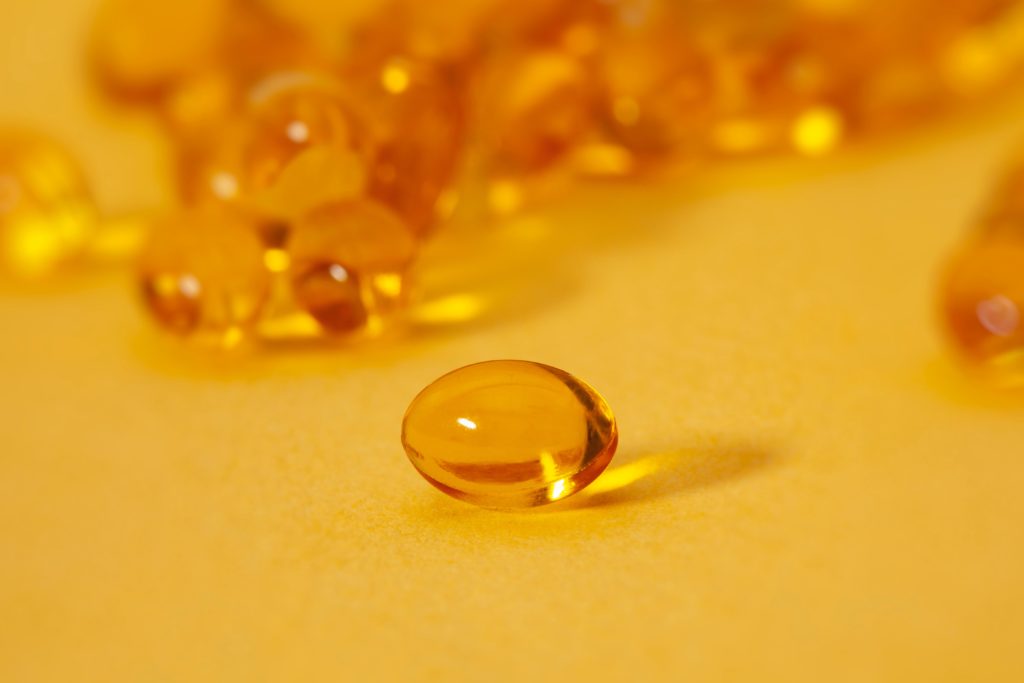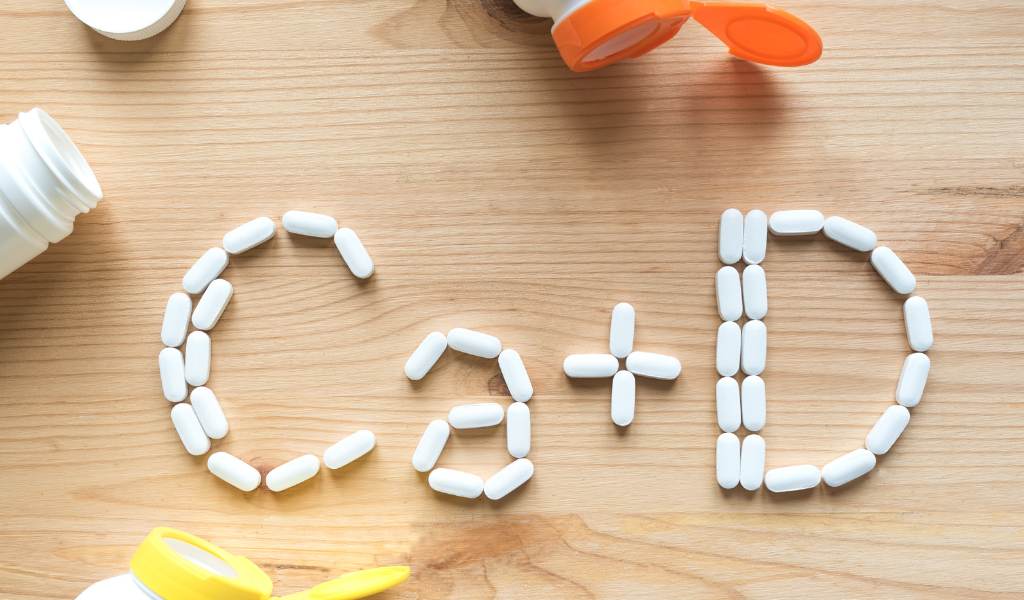Endocrinologist Olesya Bruslik answers the most essential questions about the most important vitamin. How to take vitamin D correctly? At what time? Before or after meals? Olesya will reveal all the details that will boost this vitamin’s efficiency and ensure its safety for your body.
Hardly anyone doubts that the “solar” vitamin D is vital for the human organism. And if you doubt, how to take vitamin D correctly, then you should read this article all the more! This vitamin is crucial not only for normal skeletal construction but also for the functioning of 2000 (!) genes in the body and the prevention of around 200 (!) diseases. Southerners who live below the 37th parallel can get this vitamin the most natural way, through their skin. It’s enough for them to simply enjoy the sun, without forgetting to apply for SPF protection, of course. Northerners have to delve into detailed articles to maintain the right levels of vitamin D in their bodies. Let’s find out how to properly consume this important vitamin!
What kind of vitamin D test do you need to take?
The 25 (OH) D determination. When you take a vitamin D test for the first time, it would also be reasonable to determine the content of ionized calcium in your blood. This will help rule out contraindications to prescribing vitamin D.

How to interpret the result?
The Association of Endocrinologists adheres to the following principles:
- Less than 20 ng/mL (50 nmol/L) — severe vitamin D deficiency
- 21-29 ng/ml (51-74 nmol/l) — regular deficiency
- 30-100 ng/ml (75-250 nmol/l) — normal levels
The whole point is that vitamins work on the principle of priority. What does vitamin D do? It’s responsible for phosphorus-calcium metabolism. If the vitamin D levels within your body are low, 100% of it will be directed to cope with this task. If you want “our hero” to contribute to your immune system, protect you against cancer and help you in other ways, its levels have to be higher.
After analyzing numerous studies, I came to the conclusion that the ideal range is 70-90 ng/ml. Higher values can increase cardiovascular risks. This range remains relevant for people of both genders and all ages.
When and how to take vitamin D?
In the first half of the day, as it can have an agitating effect on the nervous system, due to which you might struggle to sleep. This is especially true for children.
Vitamin D is fat-soluble. Therefore, it is best absorbed with fatty foods. A keto breakfast with eggs and a dose of vitamin D is just what the doctor ordered.
It’s recommended to take vitamins D and E separately — otherwise, the absorption of both will decrease.
Vitamin D, vitamin K and calcium act synergistically. However, it’s not necessary to take them in one supplement. The most important thing is to have sufficient levels of these elements in your body. Then, they will work smoothly as a team.

How much to take: a prophylactic dose of vitamin D
The commonly prescribed preventive dose of vitamin D is 800 IU. This amount is necessary to maintain normal phosphorus-calcium metabolism.
Make sure to significantly increase the dose if you need to drive down cancer and autoimmune risks, overcome excess weight, reduce general inflammation as well as prevent atherosclerosis and diabetes. Most studies recommend a dose of 2,000 units for these purposes. Other studies show that a dose of 5000 units saves us from cancer and strengthens our immune systems.
In practice, everything is individual. Some people need 2000 IU to maintain the normal level, others need 5000 IU to have a higher vitamin D level than recommended. That’s why I consider 2000 IU as a safe prophylactic dose. Taking higher doses should be supervised by a physician. It is certainly not safe to take 10,000 IU of vitamin D over a long period of time, such as over half a year.
Vitamin D deficiency: What to do?
The therapeutic dose of vitamin D should be prescribed by a doctor, based on the results of the tests that assess your levels of vitamin D and calcium. In no case should you self-medicate if you have gastritis, peptic ulcer disease, kidney concrements, low traumatic fractures or were diagnosed with osteoporosis at a young age (under 50 years).
What’s the best way to take vitamin D: once per week or daily?
That’s up to you. If you’re a responsible patient, don’t suffer from memory problems and aren’t afraid of pills, take it daily. Since you are reading this article, you seem to be that kind of person. I, on the other hand, have been in touch with less responsible patients for a long time. I’m used to prescribing them this vitamin 1 or 2 times per week. Such a regimen would be just as effective. But remember: a single dose of vitamin D shouldn’t exceed 10,000 IU, according to our national guidelines.
How likely is a vitamin D overdose?
As I wrote above, a single dose shouldn’t exceed 10,000 IU. The only exception is rare cases of vitamin D receptor defects.
Continuous intake of 10,000 IU or more over a long period of time is not safe.
Even a dose of 2,000 IU, let alone 4,000-5,000 IU, can cause vitamin D levels to rise above the recommended norm. Such intake won’t cause overdose symptoms but it can drive up the risk of cardiovascular complications and calcification of your kidneys.
I, therefore, recommend that vitamin levels should be tested twice per year on a continuous dosage of 2000 IU or more.
These numbers are only valid for adults.

Can I be allergic to vitamin D?
You can’t be allergic to vitamin D itself. But you can easily be allergic to a drug. After all, apart from the vitamin itself, it contains many other components. If you or your child has a rash, it’s not the reason to cancel the vitamin’s intake, but rather to change the supplement. As a rule, liquid fat-soluble forms tend to be less allergenic.
Vitamin D: contraindications for taking it
If you have a stomach ulcer, gastritis or kidney stones as well as osteoporosis or nontraumatic fractures (fractures with minimal traumatic effects) under the age of 50, you should only take vitamin D after an appointment with an endocrinologist, even at a preventive dose.
If calcium deposits have already been detected in your body, be careful with vitamin D. Keep reading this article to find out why.
When to take vitamin D along with calcium?
Look for calcium in almonds, broccoli, cheese, spinach and kale but not in milk.
Vitamin D along with calcium is taken to treat osteoporosis and eliminate some postoperative complications. However, only a medical professional can prescribe it to you.
For a person without a medical degree it’s enough to know this fact: if there’s not enough calcium in your diet, you need an additional dose of it. Find out which products contain this mineral. Scrutinize your diet: does it include these products? Satisfying your daily demand for calcium is the key to having healthy bones after menopause.
After menopause, it’s not easy to meet your daily calcium needs, which is 1500 IU, from your diet only. You have to take extra calcium as well.
If you need a large dose of vitamin D, you’d better choose a drug without calcium in its formula. Although combined products feature a very small dose of this vitamin, you can get an overdose of calcium if you use them to satisfy your need for vitamin D.

Can I take calcium without vitamin D?
Taking calcium and vitamin D together isn’t mandatory. The most important thing is that your vitamin D levels remain normal. Then, the calcium will be absorbed perfectly. But if your vitamin D levels are low, you shouldn’t take calcium in any way! Low vitamin D levels often cause hyperparathyroidism — a hormonal disorder that makes the body try to increase blood calcium levels. If you give extra calcium to your body, be ready to face calcinates and cardiovascular complications. Without vitamin D, most of the calcium will leave your body through your kidneys instead of being reabsorbed and provoking kidney stones.
Both vascular calcinates and kidney stones can occur when you overdose on vitamin D. So I repeat: I recommend checking your vitamin D levels twice per year and adjusting the dose.
When taking therapeutic doses of vitamin D to eliminate deficiencies, it’s not recommended to supplement it with calcium intake! An additional supplement of calcium makes sense if your diet lacks this element and you’re taking a prophylactic dose of vitamin D. It would be reasonable to opt for the chelated form of calcium, such as Carlson Labs Chelated Calcium or Source Naturals Calcium.
Should you take vitamin D along with vitamin K? Examples of vitamin D supplements
Taking vitamin D with low levels of vitamin K can play a cruel trick on you. The fact is that vitamin D activates the synthesis of the matrix protein GLA, which is involved in the calcification of the arteries. Vitamin K turns this protein into another form, channeling its activity in the right direction.
So watch out for the presence of vitamin K in your diet! According to statistics, its deficiency is not too common. Plus, I must say, it’s not too well studied. Instead of relying on statistics, let’s take care of ourselves in this aspect.
The main sources of vitamin K are fermented plant foods (like sauerkraut), liver, eggs and dairy products. Pay special attention to fermented products — their bacteria produce vitamin K like a house afire. In general, if you’re on a keto/LCHF diet, you’re probably getting enough of this vitamin from food.

When taking high doses of vitamin D (over 2000 IU), I recommend measuring your vitamin K levels in advance. If they’re insufficient, take vitamin K additionally. Here are some good complex vitamin D supplements:
- Solaray Vitamin D-3 K-2 — Vitamin D at a dose of 5000 IU
- Now Foods Vitamin-D-3 K-2 — Vitamin D at a dose of 1000 IU
- Carlson Labs Vitamin K2 — contains only vitamin K, allowing you to take vitamin D at your own dose. This product boasts a perfect price/quantity ratio: one pack will last you for six months.
Unfortunately, you can’t compensate for an already-formed vitamin K deficiency with food alone. But it’s possible to maintain the achieved result with a properly organized diet! And this is the best option.
There is another benefit of taking vitamin K together with vitamin D. Studies have proved that thanks to combining vitamin D with other vitamin K supplements, you’ll achieve the best effect in strengthening your bones and curing osteoporosis.
If calcinates have already been detected in your body, I recommend taking only a combined supplement.
Attention: All recommendations on supplements are based on Dr. Olesya Bruslik and Olena Islamkina’s personal preferences. The authors of this text don’t receive any bonuses or rewards from drug manufacturers. They are convinced that vitamins and minerals should be obtained from food in the first place.

